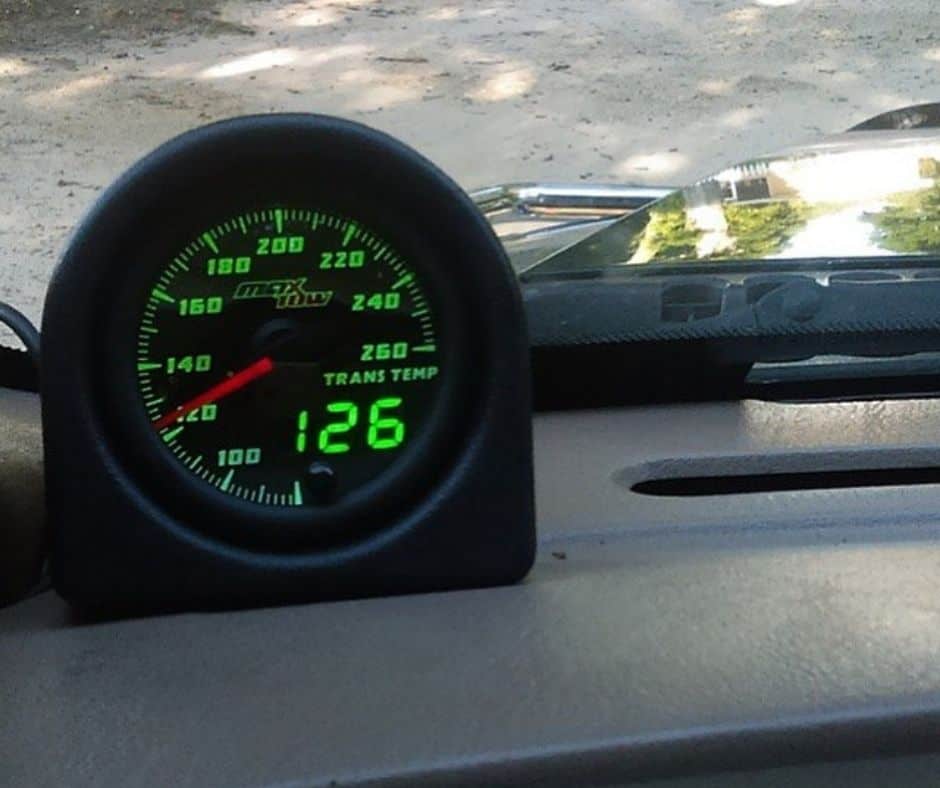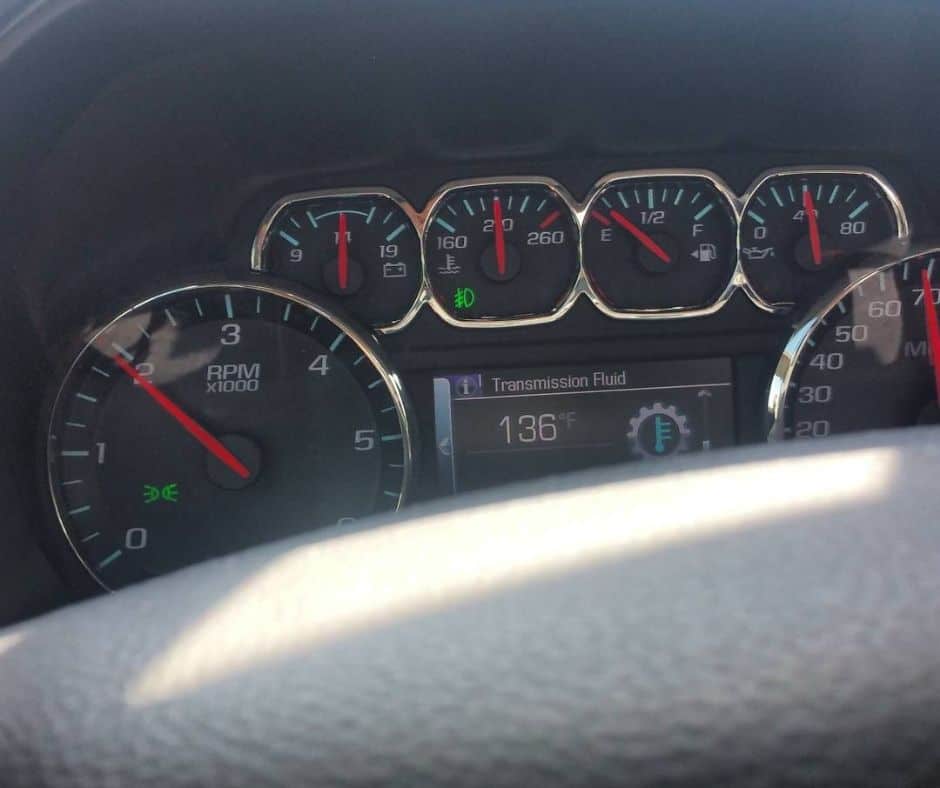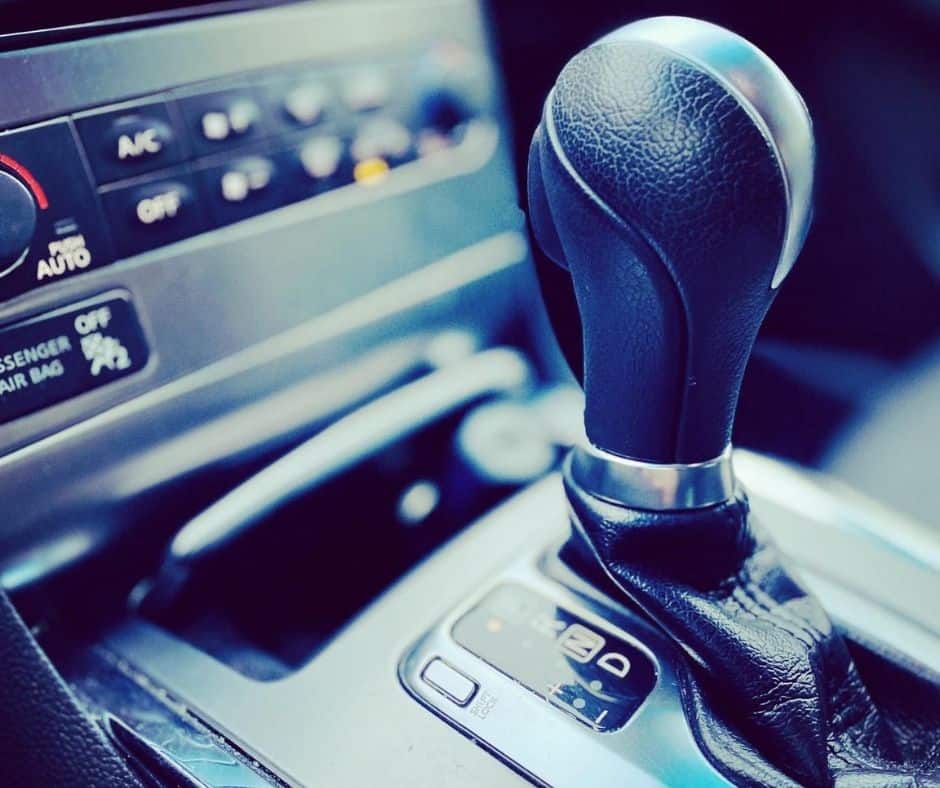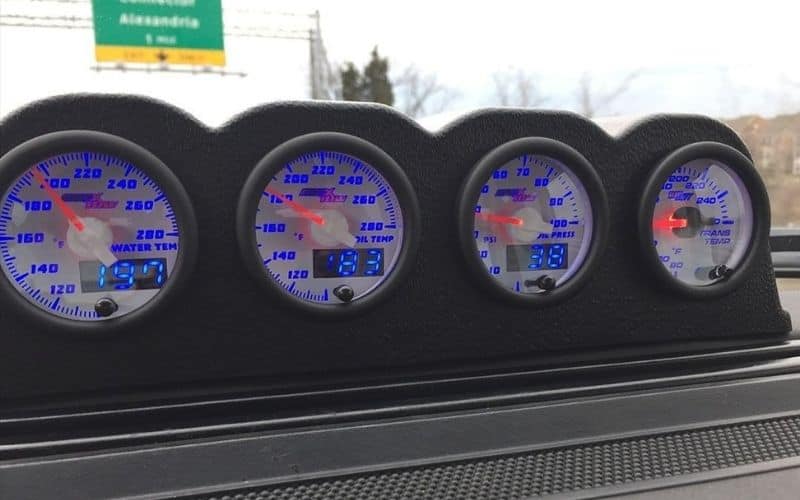Towing puts increased strain on both a truck’s engine and transmission.
While most people are aware of the impact of engine temperature on performance and have a gauge in their instrument cluster to tell them the engine temperature, transmission temperature is something that isn’t as well understood.
Yet transmission performance relies on keeping the transmission properly cooled.
Compounding this is the fact that when a transmission overheats it can cause severe damage to any one of several important components.
This can leave you stuck on the side of the road, facing an expensive repair that takes days if not weeks, and unable to complete the rest of your RV vacation.
We put this article together to arm you with better working knowledge of normal transmission temperatures and how to prevent the transmission from overheating maintain your truck’s transmission to keep you off the hard shoulder and on your merry way.
What Temperature Does A Transmission Perform Best?
Most tow vehicle transmissions work best when the automatic transmission fluid (ATF) is warm.
Viscosity and performance start to loosen for optimal performance around 130-degrees.
Most transmissions when you aren’t towing will then run best when the ATF is around 170-degrees.
What Is A Normal Transmission Temperature When Towing A Trailer?

A typical transmission temperature for a pickup truck towing a medium load is typically between 190 to 200 degrees Fahrenheit.
This is roughly the same temperature as the engine bay itself. Though it’s worth noting that when you aren’t towing the average automatic transmission fluid temperature is right around 175-degrees.
Adding to this concern is that when you start to tow a more significant load, the temperature inside the torque converter can rise to as much as 350-degrees.
Given enough time towing under a heavy load, around 70 to 80% of the rated maximum towing capacity, this heat energy can start to migrate into other surrounding components via conduction.
The concern when it comes to transmission performance is the risk of oxidizing the automatic transmission fluid.
When this happens, the fluid starts to break down and can no longer protect the transmission parts from suffering wear and tear.
As time goes on, this can cause severe damage. Even if you stop to let the truck cool all the way down, the oxidized transmission fluid will still have lost some of its protective qualities, and you could still be putting your truck’s transmission at risk.
It can also leave varnish in the gearbox which can hamper performance.
What Temperature Does Transmission Fluid Start To Oxidize?
The automatic transmission fluid starts to oxidize around 220-degrees. This is the point when transmission overheating occurs.
If the internal components of your transmission are held at 300-degrees for an extended period of time the metal components inside the transmission can start to warp and distort. Some moving parts can even seize.
What Are Signs Of An Overheating Transmission While Towing?

There are a few key signs of an overheating transmission to look out for. This includes:
How Bad Is An Overheated Transmission?
Once a transmission starts to overheat, you are dealing with a bevy of short-term and potential long-term problems.
If the overheating is severe it can cause major damage to essential transmission components.
Sometimes it can cause the transmission to be “Stuck” in one gear, which can put further strain on other components and the tow vehicle itself.
Even if you manage to cool the transmission and engine down without a catastrophic failure, the oxidized transmission fluid can break down leaving varnish in the gearbox that affects future performance.
Oxidized transmission fluid also loses some of its protective qualities, meaning that your transmission will be running without the proper lubrication until the ATF is changed out.
What Causes Transmission Overheating

While towing certainly creates more heat than simply running under normal conditions, other things can increase your risk of overheating your truck’s transmission. This includes things like:
Towing Under Heavy Load For A Prolonged Period Of Time
When you are towing a heavy load the heat from the transmission’s torque converter will inevitably start to spread to the rest of the transmission and surrounding components. This is also compounded by the heat of the engine block heating the rest of the engine bay when you are towing under a heavy load.
Low Transmission Fluid
Transmission fluid plays a critical role in keeping the transmission’s components properly lubricated.
This goes a long way toward ensuring that all the components operate at an optimal rate and temperature.
When you don’t have enough transmission fluid, it can cause excess wear and tear on the transmission’s components, the cooling system won’t work properly, and the risk of overheating increases rapidly.
Oxidized Or Bad Transmission Fluid
If you frequently tow under a heavy load, and you also have a bad habit of not routinely changing your transmission fluid, your ATF can start to oxidize.
This can cause many of the same gear damage problems as running on the low transmission fluid and can also leave ATF varnish deposits in the transfer case which can affect performance.
All of these things can further put your truck’s transmission at risk of overheating.
Problems With Your Radiator Or Vehicle’s Cooling System
Your truck’s radiator and the rest of the cooling system components are tasked with keeping all essential components cool.
When properly maintained they should keep your engine and transmission safely cool regardless of the time, distance, or speed at which you travel.
If you are having problems with your truck’s cooling system it can cause excess engine heat and increase the risk of your transmission overheating.
Especially when you are towing and creating excessive amounts of heat energy in the engine bay and inside the transfer case.
Inclement Hot WeatherOr Terrain
A summer heatwave can make it hard for your truck’s cooling system to cool the engine and transmission.
In excessively hot and dry conditions, you might find your transmission tending to overheat more quickly.
This can further contribute to other issues like ATF oxidation, which compounds the overheating problem in your truck’s transmission.
Ideally, you want to give your vehicle plenty of time to cool down after a long drive or towing under a heavy load.
Even something like parking in a shaded location might help keep essential parts cool.
Solenoid Problems
A faulty or failing solenoid can also cause transmission overheating issues.
The solenoid in the transmission is essential an electro-hydraulic valve that regulates the fluid flowing into and out of the automatic transmission gearbox.
When a solenoid has a problem then the correct volume of transmission fluid doesn’t flow properly, which further increases the risk of overheating.
Transmission Sensor Failure
Automatic transmissions like you find in most pickup trucks have multiple electric sensors to control transmission operations.
If one or more of these sensors fails,the transmission won’t operate properly.
This can cause any number of overheating issues. Though most of the time, these sensors are directly connected to the vehicle’s onboard computer, and you will see a “Check Engine Light” or “Check Transmission Light” appear on your instrument cluster.
How To Prevent Transmission From Overheating

There are a few different things you can do to prevent transmission overheating and oxidizing your transmission fluid.
Install A Special Transmission Cooler
Also known as a “Transmission Radiator” a transmission cooler is engineered to dissipate heat energy by constantly agitating the transmission fluid as it circulates through the transmission components.
Most include a thermostatic flow controller to promote the ideal temperature of the transmission.
A transmission radiator can be installed in different locations in the engine bay, depending on the make and model of the pickup truck.
For optimum performance, it should be installed in front of all other heat exchangers.
By placing it in front of things like the radiator, air conditioning system, and condenser, ensures that it is getting the freshest air possible and isn’t competing with the heat exuded by these other exchangers.
However, this isn’t always possible in 100% of trucks. So, it’s best to have a transmission cooler installed by a radiator specialist who can find the best possible location for your vehicle.
Every time the transmission oil cools by 20 ° F (7 ° C), the useful life of the oil and transmission parts is prolonged and, consequently, that of the vehicle.
This is why it is so important not only to equip your car with a transmission cooler but also to have it professionally installed.
Properly Maintain Your Vehicle & Transmission
Routine maintenance is the best defense against all sorts of mechanical problems, including an overheating transmission.
This includes things like routine oil changes for the engine, replacing the ATF fluid according to the owner’s manual recommendations, and the age of the vehicle.
It also means properly maintaining your cooling system and flushing the radiator when needed to maintain optimal performance.
Be Mindful Of Overheating
When overheated even for a short amount of time ATF fluid can start to oxidize. Even when it cools down, it won’t have the same protective properties.
If you have been doing a lot of heavy towing, or you know you’ve been pushing your limits on the transmission fluid, take it in to have it checked and changed.
Drive & Tow With Care
Responsible driving habits and wise towing habits will go a long way toward preventing transmission overheating and damage.
This includes doing things like coming to a complete stop before shifting gears, and not idling for long periods.
Do your best to accelerate and decelerate gradually, especially when towing.
Conclusion
All transmissions do best when they are a little warm, which tends to be when the automatic transmission fluid is between 130 to 175-degrees.
If you push the temperature of your transmission above 220 degrees and keep it there, the ATF can start to oxidize, and the transmission will be at increased risk of overheating.
Having an aftermarket transmission cooler or radiator installed by a radiator expert will go a long way toward keeping your transmission in the safe zone.
Especially if you frequently need to tow a heavy load. You can follow this up with sound driving practices, and staying on top of routine maintenance.





![8 Best Stabilizer Hitches for Travel Trailers in [currentyear]: Find the Perfect Weight Distribution Hitch 9 Best Weight Distribution Hitch](https://www.rvingknowhow.com/wp-content/uploads/2020/06/Best-Weight-Distribution-Hitch.jpg)
